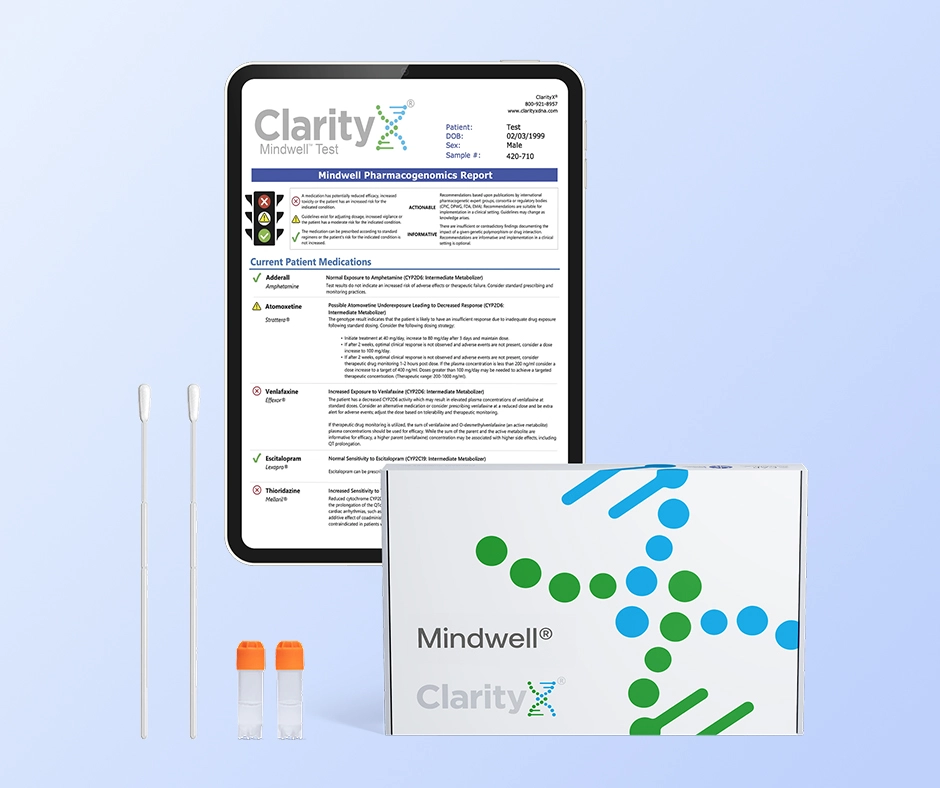Key Highlights
- Prozac® (fluoxetine) is a commonly prescribed antidepressant medication that belongs to the class of drugs called selective serotonin reuptake inhibitors (SSRIs).
- Prozac is used to treat various mental health conditions such as major depressive disorder (MDD), obsessive-compulsive disorder (OCD), panic, and bulimia- It typically takes 2-4 weeks for Prozac to start taking effect and improve symptoms of depression and other mental health conditions.
- The initial 7 days on Prozac may be accompanied by common side effects such as nausea, headache, and trouble sleeping.
- Monitoring your symptoms and side effects during the first week and communicating with your healthcare provider is important.
- Early signs of improvement on Prozac may include relief from symptoms of depression, better focus, and psychological changes.
- Managing side effects during the first week is crucial by following medical advice and employing coping strategies.
- Beyond the first week, it's important to continue taking Prozac as prescribed, monitor long-term effects, and maintain a healthy lifestyle.
Introduction
Prozac, also known by its generic name fluoxetine, is a widely prescribed medication used to treat various mental health conditions, including major depressive disorder (MDD), obsessive-compulsive disorder (OCD), and panic disorder. With the increasing prevalence and awareness of mental health issues, having access to effective drugs like Prozac is crucial for individuals seeking relief from their symptoms and improving their quality of life.
Understanding how Prozac works and what to expect during the first week of treatment is essential for those starting their medication journey. This blog aims to provide a comprehensive guide to the initial 7 days on Prozac, including common side effects, early signs of improvement, managing side effects, and adjusting to the medication.
By exploring the timeline of Prozac's effectiveness and addressing frequently asked questions, individuals can better understand what to expect during the first week on Prozac and beyond. It's important to note that Prozac may affect individuals differently, and communication with a healthcare provider is crucial throughout the treatment process. Let's delve into the details of how Prozac works and the initial 7 days on this medication, considering various factors that may impact its effectiveness.
Understanding Fluoxetine: An Overview
Before diving into fluoxetine’s timeline for effectiveness, it’s important to discuss what the medication is and how it works. Let’s take a closer look.
What is Fluoxetine?
Fluoxetine, also known by its brand name Prozac, is a widely prescribed antidepressant medication that helps alleviate the symptoms of mental health conditions such as major depressive disorder (MDD), obsessive-compulsive disorder (OCD), and panic disorder. It belongs to the class of drugs called selective serotonin reuptake inhibitors (SSRIs), which increase serotonin levels in the brain.
By restoring the balance of serotonin, Prozac helps improve mood, reduce anxiety, and enhance overall mental well-being. The FDA approves Prozac to treat major depressive disorder, obsessive-compulsive disorder (OCD), panic disorder, bulimia nervosa (an eating disorder), and premenstrual dysphoric disorder (PMDD).
As a generic medication, fluoxetine is available from various manufacturers and is commonly prescribed due to its effectiveness and tolerability. It is important to note that fluoxetine should be taken under the guidance of a healthcare provider and as prescribed to ensure maximum safety and efficacy. Consultation with a healthcare professional is crucial to determine the appropriate dosage, including starting at a lower dose and clarifying the intended duration of treatment with fluoxetine.
How Fluoxetine Works in the Brain
Fluoxetine, or Prozac, works by increasing serotonin levels, a neurotransmitter in the brain that plays an important role in regulating mood and emotions. Serotonin is involved in transmitting signals between neurons and is often called the "feel-good" chemical. Low levels of serotonin have been linked to depression and other mental health conditions, highlighting the important role that serotonin plays in our overall well-being.
As a selective serotonin reuptake inhibitor (SSRI), fluoxetine blocks serotonin's reabsorption, or reuptake, in the brain. This increases serotonin levels available, allowing for better communication between neurons and a more balanced mood. By restoring serotonin levels, fluoxetine helps alleviate symptoms of depression, anxiety, and other mental health conditions.
The effects of fluoxetine may take time to fully manifest, typically within 2-4 weeks of consistent use. It is important to continue taking fluoxetine as prescribed, even if you do not feel immediate effects, as the medication works gradually to achieve its therapeutic effects.
The Initial 7 Days on Fluoxetine
The first week of using fluoxetine (Prozac) is crucial as your body adjusts to the medication. During this time, it is common to experience certain side effects as your body adapts to the new medication. It's important to remember that everyone's experience may vary, and not all individuals will experience the same side effects when they first start taking Prozac.
The initial seven days of treatment may involve common side effects such as nausea, headache, and trouble sleeping. These side effects are generally mild and temporary and subside as your body becomes accustomed to the medication. Monitoring your symptoms and communicating with your healthcare provider can help manage any discomfort during this initial period.
Day-by-Day Breakdown: What to Expect
During the first week on fluoxetine, it is important to be aware of potential side effects that may arise. Here's a day-by-day breakdown of what to expect during the initial 7 days of treatment:
Day 1:
- Some individuals may not experience any noticeable effects on the first day.
- Others may start to feel slight changes in mood or energy levels.
Day 2-4:
- Common side effects such as nausea, headache, and trouble sleeping may start to manifest.
- Staying hydrated and getting plenty of rest during this time is important.
Day 5-7:
- Side effects may persist or gradually subside as your body adjusts to the medication.
- Some individuals may start to notice improvements in mood and overall well-being.
It's important to remember that the timeline and intensity of side effects may vary from person to person. Consult your healthcare provider for guidance if you have concerns or if side effects become severe.
Common Initial Reactions and How to Cope
During the first week on fluoxetine, it is common to experience certain side effects as your body adapts to the medication. While side effects are generally mild and temporary, knowing how to cope with them is important. Here are some common initial reactions and coping strategies:
- Nausea: Taking fluoxetine with food or dividing the dosage throughout the day can help alleviate nausea.
- Headache: Staying hydrated and managing stress can help ease headaches.
- Trouble sleeping: Practicing good sleep hygiene, such as establishing a bedtime routine and creating a relaxing sleep environment, can promote better sleep. It may also be helpful to discuss adjusting the timing of the medication with your provider.
It's important to communicate any concerns or discomfort with your healthcare provider. They can provide guidance, adjust the dosage if necessary, or suggest coping strategies to manage side effects more effectively.
Early Signs of Improvement
After the initial week of fluoxetine, individuals may start to experience early signs of improvement. While the medication can take several weeks to reach its full effectiveness, there are potential indicators of progress to watch for.
Early signs of improvement may include:
- Symptom relief: Reduction in symptoms of depression, anxiety, or other mental health conditions.
- Psychological changes: Potential examples include improved mood, increased motivation, and better emotional well-being.
- Effects of Prozac: Enhancements in focus, concentration, and overall cognitive functioning.
It's important to note that individual responses to fluoxetine may vary. It is essential to continue taking the medication as prescribed and communicate any changes or concerns with your healthcare provider.
Psychological Changes to Look Out For
As fluoxetine begins to take effect, individuals may notice various psychological changes. These changes can manifest in different ways, and it's important to monitor and communicate any notable shifts in your mental health. Here are some psychological changes that may occur for some individuals during fluoxetine treatment:
- Better focus and concentration: Improved ability to concentrate and stay focused on daily tasks.
- Mood improvements: Reduction in feelings of sadness, anxiety, or irritability.
- Enhanced mental well-being: Increased overall sense of well-being, calmness, and stability.
It's important to remember that psychological changes may take time to fully manifest and can vary from person to person. Regular communication with your healthcare provider is crucial to monitor your progress and make any necessary adjustments to your treatment plan.
Physical Symptoms of Progress
In addition to psychological changes, there may also be physical symptoms as fluoxetine starts to take effect. These physical symptoms can vary from person to person and may include:
- Dry mouth: A common side effect of fluoxetine that can subside over time or be managed by staying hydrated.
- Weight changes: Some individuals may experience weight gain or weight loss while on fluoxetine. Maintaining a balanced diet and discussing any significant changes with your healthcare provider is important.
- Sexual side effects: Fluoxetine can impact sexual function, including decreased libido and difficulties achieving orgasm. If these side effects become problematic, consult your healthcare provider for possible solutions.
It's important to keep track of any physical symptoms and communicate them with your healthcare provider to ensure appropriate management and support.
Managing Side Effects in the First Week
Managing side effects during the first week of fluoxetine is crucial to ensure a comfortable and safe experience. While common side effects may arise, there are steps you can take to minimize their impact. Here are some tips for managing side effects during the initial week:
- Stay hydrated: Drinking plenty of fluids can help alleviate common side effects like dry mouth or headaches.
- Follow medical advice: Take fluoxetine as your healthcare provider prescribes and follow their guidance for managing side effects.
- Employ coping strategies: Practicing relaxation techniques, engaging in stress-reducing activities, and getting enough rest can help manage side effects. Building these skills is also helpful for managing stressors in the long term.
If side effects become severe or persist beyond the initial week, consult your healthcare provider for further guidance and support.
Navigating Common Side Effects
Common side effects such as nausea, headache, and dry mouth may occur during the first week or beyond while taking fluoxetine. While these side effects are generally mild and temporary, there are strategies to navigate them more comfortably:
- Nausea: Taking fluoxetine with food or dividing the dosage throughout the day can help alleviate nausea.
- Headache: Staying hydrated, managing stress, and possibly using over-the-counter pain relievers (under healthcare provider guidance) can help ease headaches.
- Dry mouth: Staying hydrated by drinking water or using sugar-free gum or mints can provide relief from dry mouth.
It's important to note that everyone may respond differently to fluoxetine and individual experiences with side effects can vary. Open communication with your healthcare provider is essential for managing side effects effectively.
When to Seek Medical Advice
While common side effects are normal during the first week of taking fluoxetine, certain situations may warrant seeking immediate medical advice. If you experience any severe side effects or concerning symptoms, such as suicidal thoughts or actions, it is important to reach out to your healthcare provider or seek medical help right away. Examples of when to seek medical advice include:
- Allergic reactions: Symptoms may include rash, hives, swelling of the face or throat, or difficulty breathing.
- Severe mood changes: Thoughts of self-harm, suicide, or extreme anxiety require immediate attention.
- Unusual physical symptoms: Seizures, fainting, abnormal bleeding, or severe muscle stiffness may indicate a serious reaction and require medical evaluation.
It's important to err on the side of caution and seek medical advice if you are unsure or concerned about any symptoms or side effects.
Adjusting to Fluoxetine: Tips and Tricks
Adjusting to fluoxetine involves adopting certain strategies and making lifestyle adjustments to ensure a positive treatment experience. Here are some tips and tricks for adjusting to fluoxetine:
- Dietary considerations: Avoid excessive alcohol consumption and discuss any dietary restrictions or concerns with your healthcare provider.
- Lifestyle adjustments: Regularly exercise, prioritize good sleep hygiene, and practice stress management techniques.
- Managing side effects: Refer to your healthcare provider's guidance for managing common side effects and employ coping strategies as necessary.
By implementing these tips and tricks, individuals can support their treatment journey and promote overall well-being while taking fluoxetine.
Dietary Considerations and Fluoxetine
Dietary considerations are important when taking fluoxetine, as certain factors can affect treatment outcomes. Here are some dietary considerations to keep in mind while on fluoxetine:
- Weight changes: Some individuals may experience weight gain or loss while taking fluoxetine. It’s important to maintain a balanced diet and discuss any significant changes with your healthcare provider.
- Eating disorders: If you have a history of or are currently managing an eating disorder, it is essential to discuss this with your healthcare provider to ensure appropriate management and support.
It's important to remember that individual responses to fluoxetine may vary, and maintaining a healthy lifestyle, including a balanced diet, regular exercise, and stress management, can contribute to overall well-being while on medication.
Lifestyle Adjustments for Better Outcomes
Beyond the first week of taking fluoxetine, implementing certain lifestyle adjustments can enhance treatment outcomes and promote overall well-being. Here are some key lifestyle adjustments for better outcomes on fluoxetine:
- Regular exercise: Engaging in physical activity can improve mood, reduce anxiety, and boost overall well-being.
- Sleep hygiene: Prioritizing good sleep hygiene, including maintaining a consistent sleep schedule and creating a conducive sleep environment, can support healthy sleep patterns.
- Stress management: Incorporating techniques such as mindfulness, deep breathing exercises, and relaxing activities can help reduce stress and improve mental well-being.
By adopting these lifestyle adjustments, individuals can complement their fluoxetine treatment and achieve better overall outcomes.
Beyond the First Week: What's Next?
While the first week of fluoxetine treatment is crucial for adjusting to the medication, the treatment process extends beyond this initial period. Here's what to expect beyond the first week of fluoxetine:
- Weeks of treatment: Fluoxetine typically takes 2-4 weeks to start taking effect and 6-8 weeks for full symptom relief.
- Long-term effects: Continued treatment with fluoxetine can lead to long-term improvements in symptoms and overall mental well-being.
- Monitoring progress: Regular communication with your healthcare provider is important to evaluate progress, adjust dosages if necessary, and address any concerns or side effects.
By staying committed to the treatment plan and maintaining open communication with their healthcare provider, individuals can confidently navigate their fluoxetine journey.
Gradual Improvements and Patience
As individuals continue their fluoxetine treatment beyond the first week, it's important to understand that improvements may occur gradually over time. Patience is key during this process, as fluoxetine takes time to reach its full effectiveness. Some key points to keep in mind include:
- Symptom relief: Fluoxetine can provide relief from symptoms of depression, anxiety, and other mental health conditions. However, the timeline for symptom relief varies from person to person.
- Quality of life: Continued treatment with fluoxetine can improve overall quality of life, including mood, energy levels, and general well-being. Complementing drug therapy with stress management skills is critical for successful treatment long-term.
- Weeks of treatment: Fluoxetine typically takes 2-4 weeks to start working and 6-8 weeks for full symptom relief. The medication must be used daily over time to become and remain effective. It's important to continue taking the medication as prescribed and communicate any concerns or changes with your healthcare provider.
By maintaining patience and staying committed to the treatment process, individuals can experience the full benefits of fluoxetine over time.
Monitoring Long-Term Effects
Monitoring the long-term effects of fluoxetine is crucial for ensuring its ongoing effectiveness and managing potential concerns. Here are some key aspects to monitor:
- Sexual side effects: Fluoxetine can impact sexual function, such as decreased libido or difficulties achieving orgasm. Communicating with your healthcare provider can help address these issues and explore possible solutions. Discussing this may feel uncomfortable, but it’s important to remember that these are biological effects, and you are not alone in managing these concerns.
- Withdrawal symptoms: When discontinuing fluoxetine, some individuals may experience withdrawal symptoms. Gradual tapering under healthcare provider guidance can help minimize these effects.
- Long-term use: Ongoing communication with your healthcare provider is essential to monitor the long-term effects of fluoxetine and make any necessary adjustments to the treatment plan.
Text table:
By monitoring these long-term effects and maintaining open communication with your healthcare provider, individuals can ensure the continued effectiveness and safety of fluoxetine treatment.
When considering treatment options your genetics can also play a vital role in determining which medications will be best suited for you. A simple test can help reduce the trial and error process associated with finding the right medication. Find out more by visiting www.clarityxdna.com
Conclusion
In conclusion, understanding the timeline of Fluoxetine's effects during the initial 7 days is crucial. Monitor both psychological and physical changes while proactively managing common side effects. Seek medical advice if necessary and adjust your lifestyle to support treatment.
Remember, gradual improvements take time, so be patient and monitor long-term effects. Fluoxetine must be taken daily consistently over time to reach and maintain its potential for providing support. Throughout your journey of managing life’s stressors, open communication of both your successes and your concerns can help you stay on the right path.
Frequently Asked Questions
How Long Until I Feel the Full Effect?
The full effect of fluoxetine can take several weeks to manifest. Typically, it takes 2-4 weeks for fluoxetine to start taking effect and 6-8 weeks for full symptom relief. Individual responses may vary, and it's important to continue taking the medication as prescribed and communicate any concerns with your healthcare provider.
Can I Drink Alcohol While on Fluoxetine?
It is generally recommended to avoid or limit alcohol consumption while taking fluoxetine. Alcohol can interact with fluoxetine and potentially increase the risk of side effects. It is important to discuss alcohol consumption and any potential interactions with your healthcare provider.
https://www.ncbi.nlm.nih.gov/pmc/articles/PMC181155/
https://medlineplus.gov/antidepressants.html
https://pubmed.ncbi.nlm.nih.gov/1564046/
https://www.accessdata.fda.gov/drugsatfda_docs/label/2017/018936s108lbl.pdf
https://www.accessdata.fda.gov/drugsatfda_docs/label/2012/021519s003lbl.pdf
https://www.medicalnewstoday.com/articles/fluoxetine-withdrawal
https://pubmed.ncbi.nlm.nih.gov/7814825/
https://www.ncbi.nlm.nih.gov/pmc/articles/PMC3168075/
https://www.ncbi.nlm.nih.gov/books/NBK554406/
https://www.hopkinsmedicine.org/health/conditions-and-diseases/premenstrual-dysphoric-disorder-pmdd
https://www.hopkinsmedicine.org/health/conditions-and-diseases/major-depression





